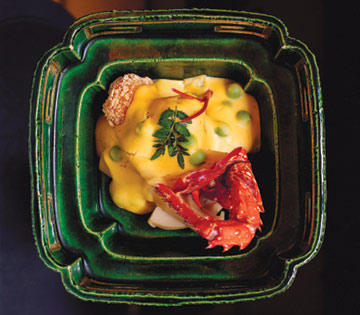
EDIBLE ART: Fried shrimp with an egg-yolk-and-green-pea sauce
Photo Essay: The Kitchen Gods
Photo Essay: Perfection in 14 Courses
The strips of dried seaweed slip and crackle under my knife. I slide the long blade through the inch-wide stack as I had been shown, but tear the fragile leaves. Yet when I use more force, the glassine sheets shatter. My companion, a four-year veteran of shredding nori at Kyoto's Kikunoi Restaurant, looks at my growing pile of misshapen slivers with concern. "They are too thick," he says, then points to his own. They are as light and fine as a newborn's hair.
I see the head chef making his way over, shove the offending pieces into my mouth and start on a fresh sheet. My tongue is washed by a burst of smoky brine. Yoshihiro Murata pauses at my station and watches me work. My hands start to sweat and the moisture glues the sheets together. "You hold your knife well," he declares. It's faint praise, but I glow anyway. Emboldened, I continue cutting, wanting to prove that a foreign apprentice can do the job; that my years as a French chef are worth something in a Japanese kitchen. Again I show my slivered seaweed to the master. He plucks three strands from the pile and drops them into a glass jar. He nods. "Better."
In a few hours those strands will garnish a medallion of tilefish wrapped around fresh soba noodles and simmered in a broth perfumed with green tea. It will be presented in a porcelain bowl that wouldn't look out of place in a museum. Borne by a waitress clad in a pale gold kimono, dish No. 5 of a 14-course menu will pass through the sliding paper door that isolates the kitchen, with its clanging pans and steaming pots, from the tranquillity of the garden-fronted dining rooms. Diners, lounging on the tatami-mat floors of the early 20th century wooden inn, may not notice just how thin the curling strands are. But they are the final flourish on a dish so sublime that I take pride in my humble contribution to one of the finest dining experiences Japan has to offer.
So traditional it's almost cutting edge, Kikunoi is a temple to authentic Japanese cuisine, and Murata is a practitioner of the craft's highest art form — kaiseki. Derived from the elaborate 16th century rituals of the Japanese tea ceremony, kaiseki has evolved into a highly formalized meal that celebrates the seasons by using only fresh, natural and local ingredients. Under an expert like Murata, kaiseki is not merely the apotheosis of Japanese cuisine, but of Japanese culture.
And it absolutely defies globalization. Unlike other Japanese culinary exports such as teriyaki, tempura and teppanyaki, kaiseki does not accommodate short cuts and substitutions. There will never be a kaiseki counterpart to America's Benihana and Britain's YO! Sushi chains. It will not fuse. In a world where the California roll, with its avocado and fake crabmeat, neatly encapsulates just how ubiquitous, how truly global, Japan's sushi tradition has become, kaiseki remains resolutely local, unique, unexportable. Kaiseki is the anti-sushi.
--------------------------------------------
As a former chef who worked in New york and Paris, I thought I knew food. My first kaiseki meal was a lesson in humility. As course followed course, I was humbled by my ignorance. These were flavors I had never encountered, vegetables I didn't recognize, cooking techniques I couldn't identify. The bite-size morsels were all carefully arranged on handcrafted dishes, a parade of edible artwork. I was mesmerized, and wanted to be initiated into the mysteries of kaiseki.
Japanese restaurant kitchens are almost exclusively the realm of men, and kaiseki is the domain of native Japanese. Gaining access seemed an impossible task — until I met Yoshihiro Murata, a third-generation kaiseki chef. As a 21-year-old, Murata chafed under the stuffy restrictions of traditional kaiseki. He left Kyoto for Paris to learn how to cook French food. In 1973, French knowledge of Japanese cuisine was limited to sukiyaki. Murata's new friends laughed when he spoke of a culinary tradition as established as France's. "It was only then that I realized that I had a lot of pride in Japanese cuisine," he says, "a lot of pride in what my family was doing."